
 Healthy and well
Healthy and well
 Ready for school
Ready for school
SETA, along with its delegates agencies and EHS partners, implement a comprehensive curriculum that meets
the needs of the children enrolled in the program. In the Head Start and Early Head Start center-based
program option, Creative Curriculum, is used. Parents as Teachers curriculum is used in
the home-based program.
Countywide, the Desired Results Developmental Profile (DRDP) is used for child assessment to measure developmental progress across multiple domains. Data is used to determine how the program has contributed to children’s growth as well as to identify areas that may need additional support.
| Domain | Approaches to Learning |
Social-Emotional Development |
Language and Literacy Development |
Cognition, Math and Science | Physical Development | English Language Development |
|---|---|---|---|---|---|---|
| Fall 2022 | 45% | 47% | 42% | 51% | 65% | 57% |
| Winter 2023 | 67% | 68% | 64% | 61% | 81% | 67% |
| Spring 2023 | 74% | 78% | 74% | 73% | 84% | 74% |
| Percentage of Growth |
64% | 65% | 76% | 42% | 29% | 29% |
| Domain | Approaches to Learning |
Social-Emotional Development |
Language and Literacy Development |
Cognition | Physical Development |
|---|---|---|---|---|---|
| Fall 2022 | 24% | 19% | 29% | 15% | 28% |
| Winter 2023 | 27% | 30% | 34% | 22% | 40% |
| Spring 2023 | 31% | 31% | 35% | 22% | 36% |
| Percentage of Growth |
29% | 63% | 21% | 40% | 29% |


The Office of Head Start (OHS) uses the Classroom Assessment Scoring System (CLASS)® as a benchmark for high-quality teacher-child interactions. Scores are categorized into three domains. Programs use their CLASS observation results to guide professional development for teaching staff to improve and/or strengthen their interactions with children in the classroom.
| Countywide Scores | Sacramento CLASS Video Pilot Scores | Regional CLASS Video Pilot Scores | |
|---|---|---|---|
| Emotional Support (ES) Domain |
6.50 | 5.94 | 5.91 |
| Classroom Organization (CO) Domain |
6.26 | 5.76 | 5.70 |
| Instructional Support (IS) Domain |
3.13 | 2.84 | 2.85 |
| SETA and 5 Delegate Agencies | |
|---|---|
| Emotional Behavioral Support (EBS) |
6.67 |
| Engaged Support for Learning (ESL) |
4.40 |
Preschool
In Emotional Support, the lowest dimension was Regard for Student Perspective at 5.58, while the highest was Teacher Sensitivity at 6.75.
In Classroom Organization, the lowest dimension was Instructional Learning Formats at 5.36, while the highest was Productivity at 6.84.
In Instructional Support, the lowest dimension was Concept Development at 2.61, while the highest was Language Modeling at 3.56.
EHS
In Emotional and Behavior Support, the lowest dimension was Regard for Child Perspective at 5.49, while the highest was Teacher Sensitivity at 7.0.
In Engaged Support for Learning, the lowest dimension was Quality of Feedback at 3.57, while the highest was Facilitation of Learning and Development at 5.62.
Supportive Applications
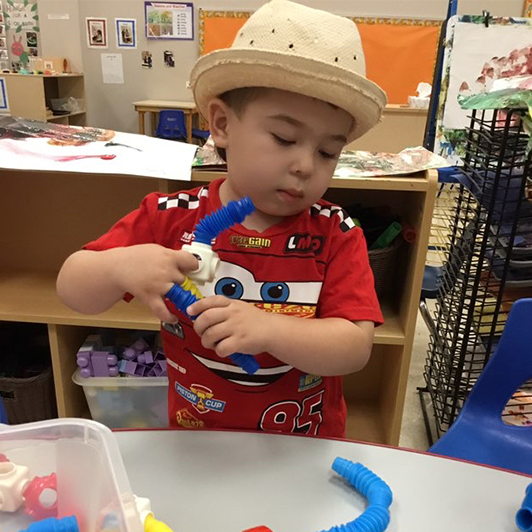
Through the home visiting program, Home Educators partners with parents and guardians to engage their children in
learning activities using materials readily available at home. Staff coach parents as they play and teach their children
during learning activities. Staff and parents conduct educational and health screenings together. Twice a month, group
socialization is held either in a classroom setting or public spaces such as public libraries and parks.
Comprehensive services are provided by integrating health, dental, and mental health curriculum in-home activities. In
addition to enrolling newborn to three-year-old children in Early Head Start and three-to-four-year-old children in Head
Start, agencies also enroll pregnant mothers. Staff assist enrolled pregnant mothers in accessing pre-natal and
postpartum health services, post-partum depression screenings, and nurse visits after delivery.
SETA, San Juan USD, River Oak Center for Children (ROCC) Early Head Start, and Sacramento County Office of Education
(SCOE) Early Head Start programs use the Parents As Teachers (PAT) home-based curriculum for children and Partners for a
Healthy Baby for pregnant women.


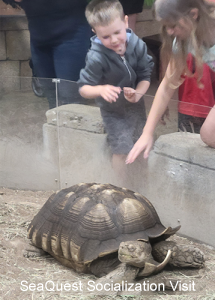

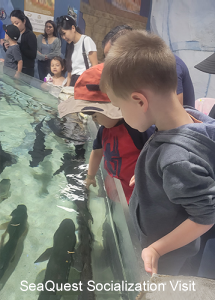
WESTED PRE-K MATHEMATICS TUTORIAL PROJECT
SETA has partnered with WestEd, a non-profit education research agency, to conduct a study of a math tutoring program for pre-kindergarten children who are behind in their math development. Previous studies showed that Pre-K Mathematics Tutorial (PKMT) curriculum caught children up and helped address pandemic-related learning loss. Twenty-two (22) SETA classrooms are participating in the project and identified students are provided hands-on math experiences in small groups five days per week. These math activities are taught according to a research-based scope and sequence of learning objectives. Teaching staff also received professional development hours on strengthening math concepts in their classrooms.
PRE-K MATHEMATICS TUTORIAL PROJECT
In the 2022-23 school year, children who were in the treatment conditions had a greater rate of change, indicating significantly more growth in their math knowledge across the year compared to BAU (business-as-usual). Furthermore, children in the pullout treatment condition significantly outperformed the BAU children on both math measures per the data collected.
This year, another ten classes will be able to implement math activities in their classroom to strengthen children’s skills in math knowledge that will include scaffolding and extending the learning.
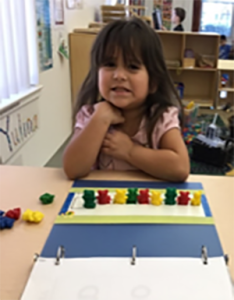
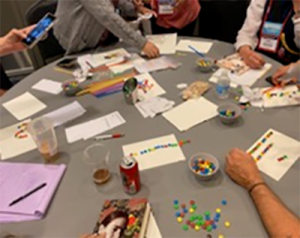
A longstanding partnership with CSU Sacramento has continued to provide student volunteers to support children’s learning. The partnership offers 20-30 students each semester who serve as SETA substitute teachers in the Head Start and Early Head Start classrooms. The students are enrolled in work participation college coursework that blends practical learning theories in early care and education with hands-on experiences in the preschool and infant/toddler classrooms.
JumpStart provided eighteen (18) college students that were located at six (6) Head Start locations. They provided additional curriculum activities that focused on literacy and social-emotional skills. Results from a recent study found that JumpStart children make 1.5x greater gains in important literacy skills than those who don’t receive the JumpStart program.
The Apprenticeship Cohort was a call to our agency’s and the community’s needs. The program employed Head Start parents and community members interested in the field of Education but had little experience or formal college education. This program combined on-the-job training with the help of mentor Teachers and classroom instruction through a collaboration with Los Rios. Apprentices received ongoing training and were supervised by skilled Site Supervisors who guided them through their on-the-job process. Apprentices gained hands-on experience and developed the necessary skills to be quality Teachers. They also learned how to implement small and large group activities using best practices. At the end of the first Apprenticeship Cohort, twenty-one (21) apprentices completed the twelve (12) college units required for an Associate Teacher permit.
The Go, Glow, Grow curriculum was designed by the University of California Agriculture and Natural Resources to support teachers in promoting healthy lifestyles in preschool classrooms. The age-appropriate small and large group activities in the resources encourage children to eat healthy foods that promote brain growth and healthy bodies. Caregivers play an essential role when they model food tasting and create a positive environment that supports mealtime behavior, picky eaters, and children experiencing food insecurity.
Parent letters, in conjunction with the lessons, allow for the home-school connection. Families also receive healthy recipes they can complete with their children at home. Thirteen sites could take part in the pilot’s first year. Five additional sites will join the “Go, Glow, Grow” pilot this program year, and more children will learn about these healthy habits.

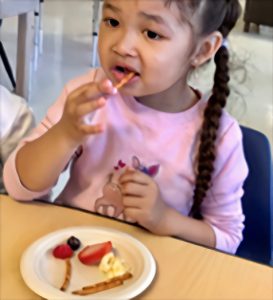
Teachers have an active role in their professional development when they participate in learning cohorts piloting new materials and resources. Teachers’ feedback is then included in the development of strategies that will be used for future implementation.
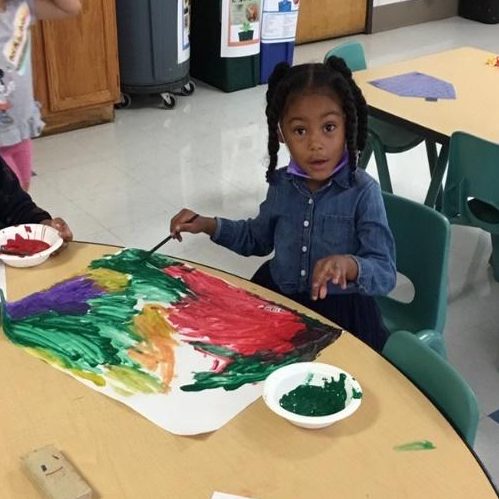
The children took turns passing around different paints.
“This is gonna be grass because grass is green.”
The teacher asked what else is green?
“The chairs and that trash can!”
Elkhorn Head Start
DRDP Measures:
COG11: Knowledge of the Natural World
COG2: Classification
LLD3: Communication and Use of Language (Expressive )
The purpose of this pilot was to provide a “road map” for teachers to organize their time and plan activities that capture each child’s unique development. Teachers in the first pilot group met all agency completion timelines. They submitted observations that were authentic, of high quality, and consistently met the appropriate DRDP measures. The Guided Observation resources were revised based on the feedback from teachers in the original pilot group. Seven additional sites will use these resources during the 2023-2024 program year.
A new Home and School Activity packet was created as a way for parents and teachers to work together to build school readiness skills. Parents introduce activities in the home, and the teachers link them to a classroom experience to reinforce skills and concepts. The parents increase their understanding of typical child development, and expectations for their children become more realistic. Strategies within the tool provide parents with observation tips to help them give input to their child’s assessment.
Children share their work from the Home and School
Activity Packet with teachers at school.
Marina Vista
“My Letter Parade”
Northview


“Every week the children draw and describe
their favorite part of a story.”
The Creative Curriculum at Fruitridge
DRDP Measures:
Language and Literacy (LLD3)
Interest in Literacy (LLD 5)
Emergent Writing (LLD 10)
Teachers, Education Coordinators, and Program Officers were introduced to the 6th Edition of the Creative Curriculum in July at an interactive and informative training presented by Teaching Strategies. The five sites included in this pilot include Mather, Walnut Grove, Sharon Neese, Bret Harte, and Dudley. These teachers are currently using the curriculum to determine the best strategies for implementation and future training for their colleagues at SETA. The teachers will have opportunities to participate in coaching groups throughout the program year as they use these new tools.
“I’m happy because my mom picked me up.”
Grizzly Hollow
Social/Emotional Understanding
STEM
Sharon Neese

The CA CSEFEL Teaching Pyramid is a framework focused on a tiered approach of evidence-based practices intended to promote healthy social-emotional development for all children, prevent challenging behaviors, and intervene by providing positive behavior support intervention.
Currently, we have nine authorized Coaches (2 in the authorization process) and five authorized trainers (1 going through authorization). In 2022-2023, 7 classes participated in the County-wide cohort and attended 5 Module Trainings with one-on-one coaching. This year, 2023-2024, 9 classes are participating; 8 attend in-person trainings in a SETA cohort, with 1 in a virtual group with the County.

“Recycling”
STEM continues to be a
concentrated curriculum area
for Head Start teachers.

Staff Wellness: Staff Wellness has been an intentional focus with access to online mental health resources and workshops on topics such as the foundations of wellness and managing change. Wellness is integrated into site meetings with the support of mind, body, and spirit. Physiological Safety, Daring Leadership, Equity and Diversity, and Trauma Informed Practices are a few of the workshops offered to staff during the virtual winter series.
All teachers received on-site training on Cultural Sensitivity introduced through children’s books.
Creating a Classroom Community, Individualization, and Building Partnerships with Families were covered in the Education Preservice this year.
Trauma Informed Care: a 6-hour session was offered to help teachers understand trauma as well as its impact on young children’s brains, behavior, learning, and development. The training introduced trauma-responsive and resilience-building teaching strategies to create strength-based environments that support children’s health, healing, and resiliency.
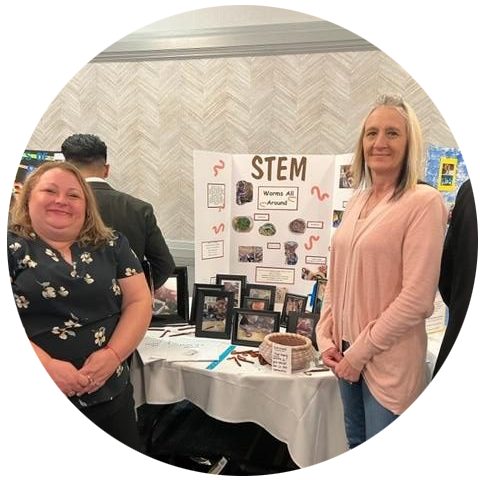
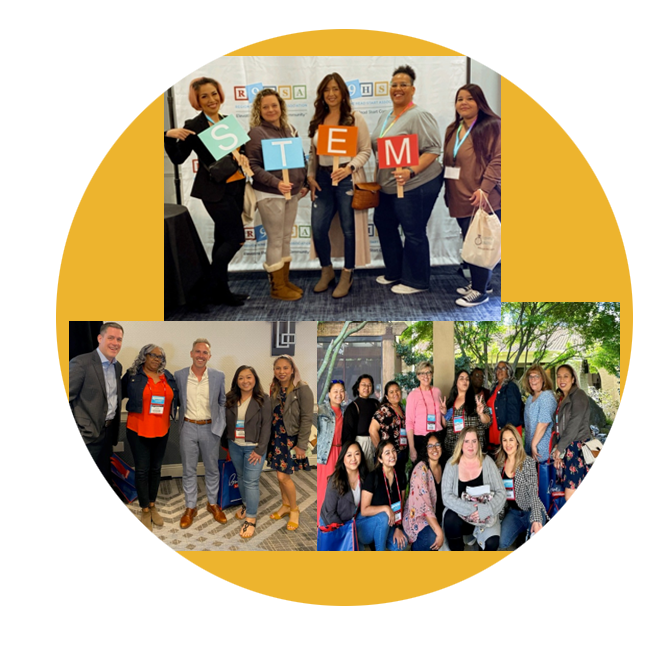
Education teams that included Preschool and Toddler Teachers attended the Region 9 STEM Institute and the California Association of the Education of Young Children Conference this year.
Teachers who attended these conferences shared their knowledge by planning and presenting at agency-wide workshops on relevant Early Childhood Education topics.
Six evenings of fun, interactive learning opportunities for teaching staff.
A sample of the in-person workshops included Building a Brain, Little Scientists, The Healing Power of Art, My Dad is a Pretzel (yoga), and Bringing Back the Fire.
Some virtual workshops included Essential Approaches to Self-Care, Trauma Informed Art, Managing Career Stress, and Investigations for Little Scientific Process.
“When You Wonder, You’re Learning”
Mister Roger’s Enduring Lessons for Raising Creative, Curious, Caring Kids
SETA Team with the authors; Gregg Behr & Ryan Rydzewski
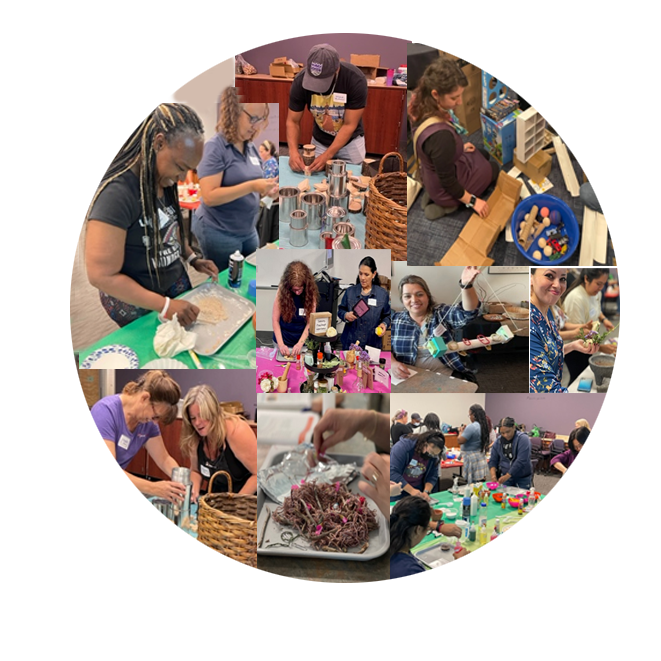
SETA Head Start classrooms participated in a music video challenge. Dudley Head Start students reviewed different songs and voted for “The World is a Rainbow”. Using this piece of music, the teachers facilitated experiences for children to learn about friendship skills, different types of families, and cultures.